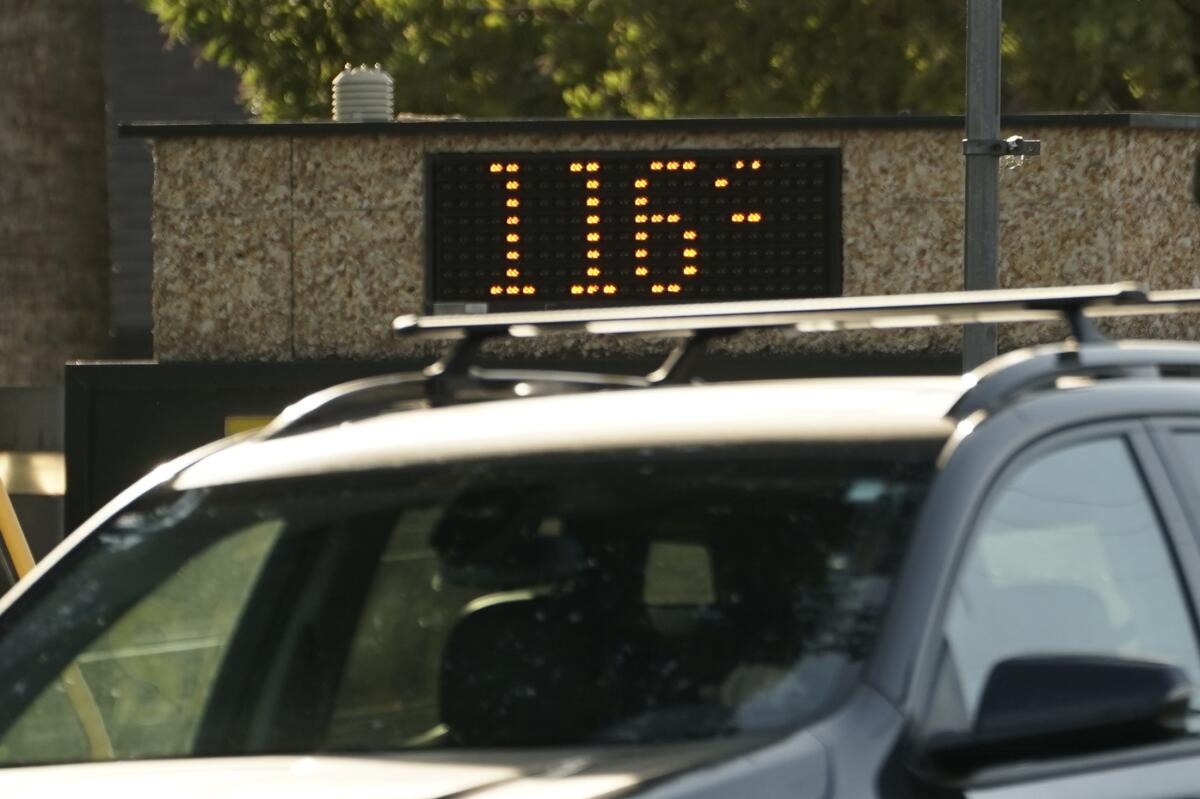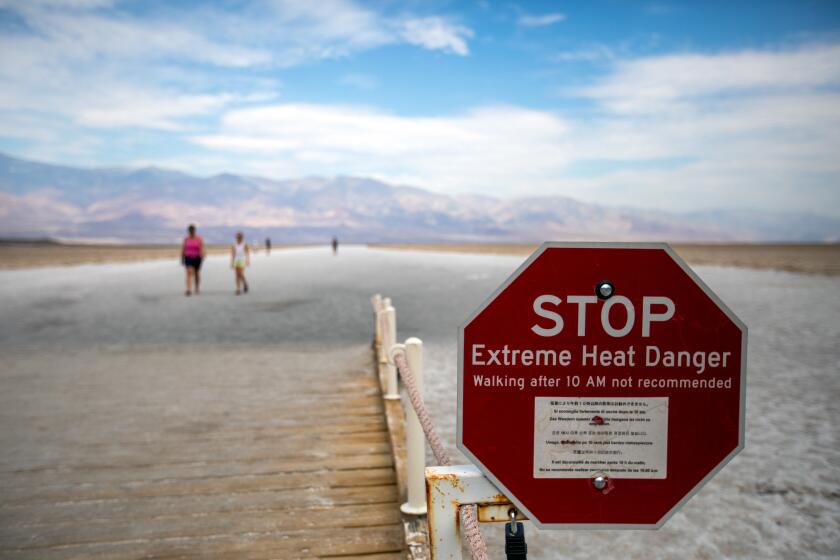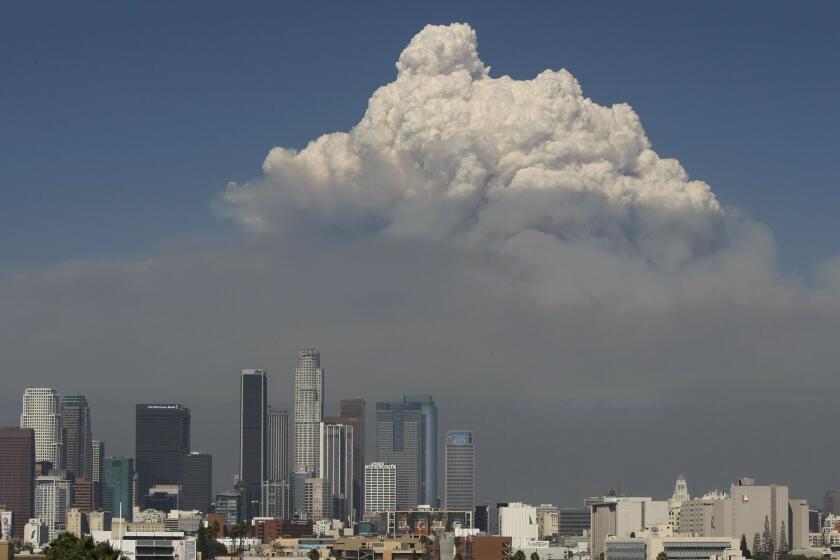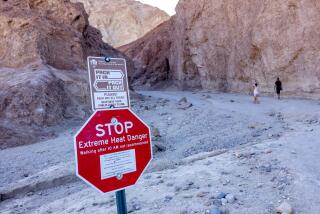Editorial: Heat waves are disasters. Why don’t they get federal disaster relief?

- Share via
When communities are hit by hurricanes, floods and wildfires they can often count on receiving federal disaster relief to help respond to the unfolding crisis and recover from its effects.
But no U.S. president has ever issued an emergency or major disaster declaration for extreme heat, even though it’s the deadliest weather-related hazard. That means that local communities and states are mostly on their own as they deal with events like this summer’s stifling, weeks-long spell of dangerous heat.
As temperatures continue to break records, it makes little sense to exclude life-threatening heat waves from federal relief. That’s why Congress should get behind the Extreme Heat Emergency Act, straightforward and common-sense legislation introduced in June by Rep. Ruben Gallego (D-Ariz.).
The mayor of Alaska’s largest city says he has a moral imperative to save lives by getting homeless people off the streets -- and onto planes to warmer climes such as Los Angeles. His moral compass must be broken.
It would amend the Stafford Act, the law that governs federal disaster relief, to include extreme heat along with 16 other types of major disasters spelled out in the law, including hurricanes, fires, landslides, drought, and high water. Though it has bipartisan support and the backing of groups such as the National League of Cities and U.S. Conference of Mayors, its prospects in the Republican-led House are unclear.
Changing the law is necessary because the Federal Emergency Management Agency has shown little interest in using its disaster relief authority for heat waves. In its history the agency has only received three requests for extreme heat declarations — the last one was in 1995 — and denied all on the grounds that they did not demonstrate that response was beyond the capabilities of state and local government.
Nothing in the law precludes an emergency or disaster declaration for extreme heat, according to the agency, but FEMA Administrator Deanne Criswell has also suggested it is restricted by the law, telling the Washington Post that “we don’t necessarily have the authorities right now within the Stafford Act.”
Experiencing extreme temperatures should not be something to check off the bucket list. This is an ongoing, spiraling, unnatural human disaster caused by our own ongoing pollution of the atmosphere.
Though applications for heat emergency relief may be harder to visualize than the rebuilding that happens after fires or hurricanes, there are many ways heat-stricken communities could benefit from federal assistance.
For example, federal funds could be used to offset the cost to local governments of responding to the surge in heat-related medical emergencies and for expanding and operating cooling centers and other shelters for the elderly, unhoused people and other vulnerable populations. Disaster relief could support hospitals and healthcare providers strained with an influx in patients, to repair or strengthen electrical and cooling infrastructure. And at the individual or household level, it could fund the installation of air conditioning and help those who do have it pay for the sky-high energy bills they’ve racked up.
FEMA says that the costs of responding to extreme heat are usually low compared to other hazards and that it’s unlikely they would reach the level that would meet the law’s requirement that a federally declared disaster be of such severity and magnitude that local and state governments can’t effectively respond on their own.
But tell that to authorities in Phoenix, where people endured a record-shattering 31 consecutive days above 110 degrees and hospitals filled up with patients with heat-related illness and even burns from touching the 180-degree pavement. The city had to deploy air-conditioned buses as mobile cooling stations, and the Maricopa County medical examiner’s office was so over capacity last month it was forced to bring in refrigerated coolers to store bodies for the first time since the peak of the COVID-19 pandemic.
There’s preliminary evidence that assigning categories and names to heat waves, like we already do with hurricanes, could help prevent deaths.
Phoenix Mayor Kate Gallego, who months earlier called for adding extreme heat to FEMA’s list of major disasters, said in an interview this week that communities across the country could use federal relief dollars to repair and strengthen power generation and backup power systems as protection against blackouts, open more cooling centers and offer financial help to people struggling to cool their homes.
“Federal assistance could save lives,” she said. “We have only so many folks in the workforce to open up and operate cooling centers. Many people in my community will have their highest ever electricity bill in the next month that will be financially devastating for some folks.”
Firefighters and meteorologists look to a little-known metric called “mixing height” to understand how explosive wildfires spread in California without wind.
Federal disaster assistance has evolved in the past, like during the COVID-19 pandemic when it was used to send billions of dollars in aid to local government and individual households, even though disease is not among the catastrophes listed in the Stafford Act. There’s no reason it can’t also adapt to accommodate the toll of extreme heat on public health and safety, especially as climate change plays an increasing role.
If used to their full potential, these disaster declarations could provide another important tool for local officials, especially in smaller communities that don’t have the resources of places like Phoenix or Los Angeles or are less accustomed such severe and long-lasting heat.
A portion of federal funding made available after a disaster declaration can also be used on projects that make communities more resilient to future disasters. That seems especially appropriate for heat waves, where there is so much work to be done to increase access to air conditioning, insulate homes, plant trees to reduce the urban heat island effect and more to address the deadly consequences of a warming planet.
The great emergency underlying all of this, of course, is climate change and the pollution causing it. President Biden and his administration need to be doing much more to restrict the extraction and burning of fossil fuels and to protect Americans from the rapidly worsening effects. That includes speeding up the development of federal workplace safety standards to protect workers from extreme heat, which is likely to take years to complete because of bureaucratic delays and industry resistance.
In the meantime, federal leaders should update the law to treat severe heat waves like the disasters they are.
More to Read
A cure for the common opinion
Get thought-provoking perspectives with our weekly newsletter.
You may occasionally receive promotional content from the Los Angeles Times.














